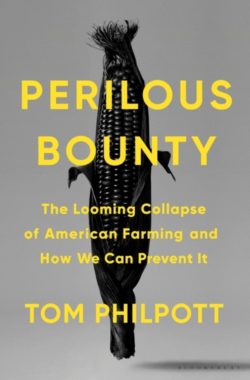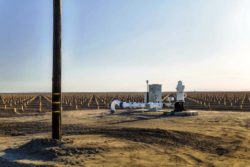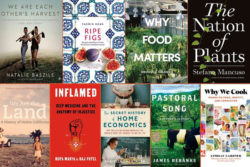Read Time: 5 Minutes Subscribe & Share
An Apocryphal Tale
 Until about 1970, Saudi Arabian deserts were sitting on a relatively untapped series of aquifers holding at least 500 billion square meters of fossil water – that is a subterranean body of groundwater that has been contained in some undisturbed space, typically for thousands of years. To give you an idea of the size of this Saudi aquifer system – it held as much water as Lake Erie. The aquifers fed various verdant oases throughout Saudi Arabian history. When modern scientific knowledge revealed the bounty of this source, the Saudi government encouraged wealthy (and part of the sprawling government “family” elite) to cash in on this underground trove. And cash in they did.
Until about 1970, Saudi Arabian deserts were sitting on a relatively untapped series of aquifers holding at least 500 billion square meters of fossil water – that is a subterranean body of groundwater that has been contained in some undisturbed space, typically for thousands of years. To give you an idea of the size of this Saudi aquifer system – it held as much water as Lake Erie. The aquifers fed various verdant oases throughout Saudi Arabian history. When modern scientific knowledge revealed the bounty of this source, the Saudi government encouraged wealthy (and part of the sprawling government “family” elite) to cash in on this underground trove. And cash in they did.
Huge farms of mostly wheat and other produce grew in the desert, and Saudi Arabia in the latter part of the 20th century became a major grower and exporter of grain and other comestibles in the Mid East. There are hundreds of these other-worldly circular fields fed by a fairly constant circular water spraying system. By the end of the 20th century, Saudi Arabia was the sixth largest exporter of food in the world. Like their cash crop of oil, water, which did not require desalinization, seemed limitless. It was not.
By the second decade of the 21st century, in less than two generations, this aquifer system has all but evaporated. The oases, some of which produced food, such as the famed Medjool dates, are drying up. The huge circular crop circles are imploding, and the efforts of a Saudi banker-turned-water-sleuth reveal the usual suspects. Elie Elhadj was puzzled by the disappearance of oases that were the backdrop of his childhood. His research and report Camels Don’t Fly And Deserts Don’t Bloom created a groundbreaking exposé on the Saudi government collusion with wealthy farmers in his country. “Nathan Halvorson’s article in Reveal makes for an easily digestible synopsis. The Saudi wheat export bonanza dried up in 2015.
Commodity Crop Complications
There are two other similar water aquifers, one crossing India and Pakistan in the Indus Basin and another in the Central Valley in California. Saudi food producers currently have bought substantial tracts of farmland in Argentina, California and Arizona to grow crops of alfalfa, which are shipped back monthly to Saudi Arabia to maintain their huge livestock inventory. Alfalfa is also a water dense crop – it needs four times as much water to grow in comparison to the water needed for a successful wheat harvest. While California, unlike Saudi Arabia, has other renewable water sources, such as river systems and snowpack (the accumulation of snow from mountainous regions, which melts in the spring and provides seasonal water for rivers and aquifers), even those “renewable” sources are in peril. California’s water supply has never recovered from a several year drought that started in 2012. As the once lush farmland areas are subverted to crops grown solely for export, which require much more water than let’s say strawberries, dwindling sources of seasonal water cannot supply enough. Then more wells are created and existing ones are dug deeper to wring out every last drop. This graph shows the extreme drought areas in dark brown from 2014 in the lower right to 2021 in the upper left. Commodity crops include alfalfa and even almonds and pistachios (unfortunately we are not talking Bronte pistachios or the Pizzuta almonds grown in Sicily, which require less water and are more drought tolerant than the variety grown in California as exportable commodity crops). Both the Sicilian Pizzuta almond and the Bronte pistachio are never irrigated, and so their flavor is more intense than the variety grown in Iran and California for export.
producers currently have bought substantial tracts of farmland in Argentina, California and Arizona to grow crops of alfalfa, which are shipped back monthly to Saudi Arabia to maintain their huge livestock inventory. Alfalfa is also a water dense crop – it needs four times as much water to grow in comparison to the water needed for a successful wheat harvest. While California, unlike Saudi Arabia, has other renewable water sources, such as river systems and snowpack (the accumulation of snow from mountainous regions, which melts in the spring and provides seasonal water for rivers and aquifers), even those “renewable” sources are in peril. California’s water supply has never recovered from a several year drought that started in 2012. As the once lush farmland areas are subverted to crops grown solely for export, which require much more water than let’s say strawberries, dwindling sources of seasonal water cannot supply enough. Then more wells are created and existing ones are dug deeper to wring out every last drop. This graph shows the extreme drought areas in dark brown from 2014 in the lower right to 2021 in the upper left. Commodity crops include alfalfa and even almonds and pistachios (unfortunately we are not talking Bronte pistachios or the Pizzuta almonds grown in Sicily, which require less water and are more drought tolerant than the variety grown in California as exportable commodity crops). Both the Sicilian Pizzuta almond and the Bronte pistachio are never irrigated, and so their flavor is more intense than the variety grown in Iran and California for export.
Agriculture Run Amuck
 Reading through Tom Philpott’s book is quite a produce education, particularly about the Central Valley, which once had enormous tracts of wetland of which only 9% remain – and that due to what the author describes as “a heroic push for restoration” by environmentalist groups who saw the results of the destruction of a necessary habitat for wild birds along the Pacific Flyway. Central Valley also produces most of the mixed salad greens – organic and non-organic that we all grab in our supermarket of choice. He also offers an introductory course in the sinking levels of land above depleted aquifers. There are
Reading through Tom Philpott’s book is quite a produce education, particularly about the Central Valley, which once had enormous tracts of wetland of which only 9% remain – and that due to what the author describes as “a heroic push for restoration” by environmentalist groups who saw the results of the destruction of a necessary habitat for wild birds along the Pacific Flyway. Central Valley also produces most of the mixed salad greens – organic and non-organic that we all grab in our supermarket of choice. He also offers an introductory course in the sinking levels of land above depleted aquifers. There are towns in this commodity crop heartland that are sinking. To quote an article in a High Country News, a regional news site:
towns in this commodity crop heartland that are sinking. To quote an article in a High Country News, a regional news site:
Each year, Corcoran’s entire 7.47 square miles and its 21,960 residents sink just a little bit, as the soil dips anywhere from a few inches to nearly two feet. No homes, buildings or roads crumble. Subsidence is not so dramatic, but its impact on the town’s topography and residents’ pocketbooks has been significant. And while the most recent satellite data showed that Corcoran has sunk only about four feet in some areas since 2015, a water management agency estimates the city will sink another six to 11 feet over the next 19 years.
Already, the casings of drinking-water wells have been crushed. Flood zones have shifted. The town levee had to be rebuilt at a cost of $10 million — residents’ property tax bills increased roughly $200 a year for three years, a steep price in a place where the median income is $40,000.
The main reason Corcoran has been subsiding is not nature. It’s agriculture.
Ignorance Is Not Bliss
 Changes to the way we buy our food are not easily achieved. We consumers make purchases out of convenience, frugality, and frequently out of ignorance. There is currently so much more information available as to how you make your choices. Personally I have found websites such as Modern Farmer and Civil Eats to be be informative and engaging. I read through them both weekly, not only for information on shaping our food policy, but also for their coverage of films, books, farming issues and sometimes just good stories. It is not easy to have to educate ourselves, but we must. Our votes at the polling station count, but so do our dollars at grocery stores and farm markets.
Changes to the way we buy our food are not easily achieved. We consumers make purchases out of convenience, frugality, and frequently out of ignorance. There is currently so much more information available as to how you make your choices. Personally I have found websites such as Modern Farmer and Civil Eats to be be informative and engaging. I read through them both weekly, not only for information on shaping our food policy, but also for their coverage of films, books, farming issues and sometimes just good stories. It is not easy to have to educate ourselves, but we must. Our votes at the polling station count, but so do our dollars at grocery stores and farm markets.

Kitchen Detail shares under the radar recipes, explores the art of cooking, the stories behind food, and the tools that bring it all together, while uncovering the social, political, and environmental truths that shape our culinary world.




Hi, Nancy. I have read in more geological (or even cosmological) writings that every molecule of water that has been on earth is still here. Interesting to complicate if not useful.
Hello David,
That is indeed an interesting observation!
Nancy
that is “contemplate.”